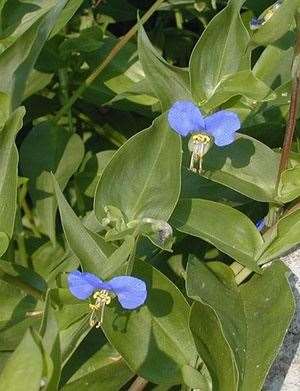Field Guide  Weed Management
Weed Management  Asiatic Dayflower
Asiatic Dayflower
Asiatic Dayflower
(Commelina communis)
Crop Impacts: Soybeans and corn
 | |
About Asiatic Dayflower:The Asiatic Dayflower is a summer annual plant that is known for being a beautiful creeper. Its main source of reproduction is done from seeds. That being said, sometimes they can reproduce by broken stems. Family: Commelinaceae family (spiderworts) 
Asiatic Dayflower Scouting and Prevention:This creeper plant can grow from 30 to 90 cm long, with many fleshy, thick, long leaves that are about 8 to 13 cm long and sit on the reddish stem. The creeper plant produces little (1.5cm in width) bilaterally symmetrical flowers. This means that the flower has 6 anthers that are irregular in size and 3 petals, 2 of which are deep blue and sit at the top and one lower peddle which is white. Interestingly enough, only a few flowers on a plant will open at one time and each flower only blooms for one day. The flowers are seen during the months of July to September. Common locations- - Partial shade
- - Moist soil
- - Edges of the woods
- - Cultivated fields
- - Soybean fields
- - Corn fields
Asiatic Dayflower Control:Cultural ControlRestricting Asiatic Dayflower from water while adding calcium and phosphorous is a good start to controlling its aggressive nature. You can also dig out the communities of Asiatic Dayflower for several years, over time the plant will start to tire out. Chemical ControlAsiatic Dayflower has increasingly been a threat to soybean and corn production due to their resistance to common herbicides. The herbicide to use depends on where you want to exterminate Asiatic Dayflower. If the weed has entered your soybean fields, herbicides with active ingredients of glyphosate work well. Latin / Alternative Asiatic Dayflower names:- - Commelina communis
- - Common dayflower
- - Blue dayflower
- - Mouse flower
- - Mouse-ears
- - Monsoon flower
Additional Asiatic Dayflower Recources |
http://plants.usda.gov/core/profile?symbol=COCO3
http://hyg.ipm.illinois.edu/article.php?id=507
http://www.bio.brandeis.edu/fieldbio/Wildflowers_Kimonis_Kramer/PAGES/ASIATICDAYFLOWER.html
http://www.nancytheweedlady.com/?p=913